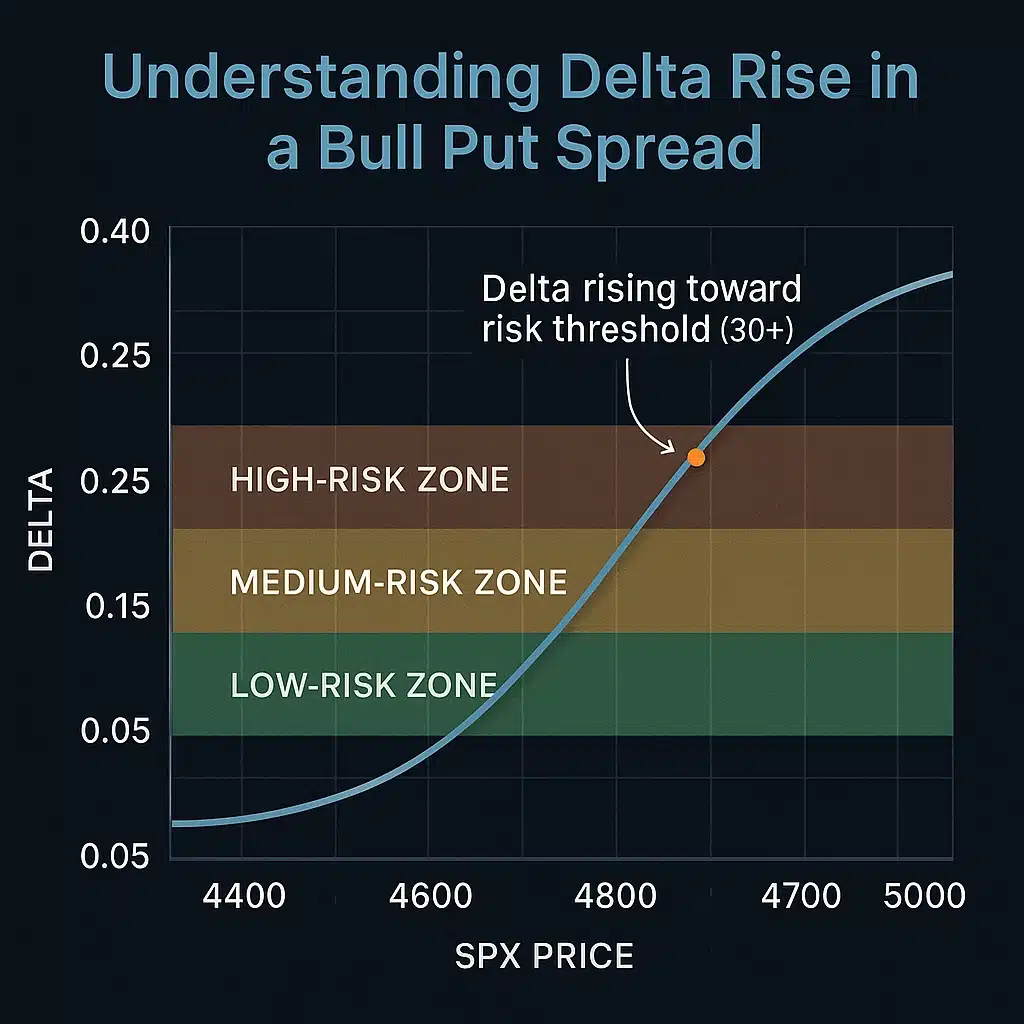A bull put spread is one of the most reliable defined-risk income strategies in options trading. If you’ve ever searched “what is a bull put spread?” or wanted to know how professionals use them for consistent SPX income, this guide walks you through the mechanics, risks, payoff structure, and exactly how I trade them.
Options trading isn’t just about predicting direction — it’s about stacking probability and controlling risk. When I started trading more than 15 years ago, I had no idea how powerful credit spreads could be. Over time, the bull put spread became a cornerstone of my SPX income strategy, and in this article I’ll show you how it works, why it works, and the exact steps I follow.
If you’re new to options, you’ve probably heard that credit spreads can generate steady premium income with limited downside. The bull put spread is one of the safest ways to do this — and the best part is that the underlying asset doesn’t need to rally. It just needs to stay above a key level.
A bull put spread is a defined-risk options strategy where you sell a put option and buy another put option at a lower strike with the same expiration date. It generates a net credit and profits if the underlying asset stays above the short strike while limiting maximum loss.
Understanding the Bull Put Spread: What It Is and Why It Works
A bull put spread is a type of credit spread created by selling one put option and buying another put option at a lower strike. Both options share the same expiration, which simplifies management.
I’ve used this strategy for years, especially in stable or mildly bullish markets. Instead of predicting a strong rally, I simply need the stock or index to remain above my short put strike — a far easier condition to meet than timing a directional move.
Breaking Down the Components
- Short Put (Sold Put): The higher strike you sell to collect premium.
- Long Put (Bought Put): The lower strike you buy to cap risk.
- Net Credit: Premium received minus premium paid — your maximum profit.
Bull Put Spread at a Glance
| Component | Meaning |
|---|---|
| Short put | Higher strike sold for premium |
| Long put | Lower strike bought for protection |
| Net credit | Maximum profit |
| Spread width – credit | Maximum loss |
| Short strike – credit | Breakeven price |
The Mechanics: How a Bull Put Spread Generates Profit
This strategy doesn’t require a rally — in fact, you can profit even if the stock moves sideways or slightly down. That’s why bull put spreads are considered high-probability income trades.
How the Numbers Work
- Breakeven: Short put strike − net credit.
- Max Profit: The credit received at entry.
- Max Loss: Spread width − credit received.
Example:
Sell $100 put for $3 → Buy $95 put for $1 → Net credit = $2.
If price stays above $100 → full profit.
If price drops below $95 → max loss = $3 (spread width $5 − $2 credit).
When to Use a Bull Put Spread
- Market is stable or slightly bullish
- Implied volatility is elevated (better premium)
- Price is above a strong support level
- You prefer defined risk over naked exposure
- You expect price to hold above a key level
Why I Prefer Bull Put Spreads Over Naked Puts
Naked puts offer more premium but expose traders to unlimited downside risk. A bull put spread defines risk upfront, requires less margin, and avoids catastrophic losses. This makes it accessible and safer for growing accounts — and it’s a core part of how I trade SPX inside my Monthly Trend service.
Step-by-Step Guide to Placing a Bull Put Spread
- Select the Right Index (SPX preferred): Strong liquidity, tight spreads.
- Choose Strike Prices: Use support levels and probability/OTM distance.
- Pick Expiration: 2–6 weeks offers strong theta decay.
- Enter as a Single Credit Spread Order: Ensure risk-reward is attractive.
- Manage the Position: Close early or roll if price approaches your short strike.
Expanding the Strategy: Adjustments and Rolling

If price moves toward your short strike, you can:
- Close early for a smaller loss
- Roll out to a later expiration
- Roll down to safer strikes
Understanding adjustments separates consistent traders from emotional traders. If you want a full professional breakdown, see my guide:
How to Fix a Losing Bull Put Spread
Real-World Example
AAPL Trade Example:
- Sold 170 put for $3.00
- Bought 165 put for $1.50
- Net credit = $1.50 ($150 per contract)
If AAPL stayed above $170 → full profit.
If it dropped below $165 → max loss = $350.
Final Thoughts: Why This Strategy Belongs in Your Toolkit
Bull put spreads are one of the most beginner-friendly ways to generate income with defined risk. Start small, focus on support levels, and use proper management. Over time, this strategy can become a consistent part of your trading system.
Bull Put Spread FAQs
What is the purpose of a bull put spread?
To generate income with defined risk by selling premium below the current price.
Is a bull put spread bullish or neutral?
It’s mildly bullish. You profit as long as price stays above the short put strike.
Why choose a bull put spread over a naked put?
Because your maximum loss is capped and margin requirements are smaller.
When should I avoid bull put spreads?
Avoid during earnings, major news events, or when implied volatility is extremely low.
Where should I place my short put strike?
Most traders choose a strike below support or where probability of ITM is under 20–25%.

